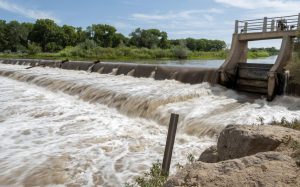
BY
What a difference the rain makes.
At the end of July, the Rio Grande ran dry in Albuquerque for the first time in nearly 40 years.
Now, the river has been revived throughout much of the city.
Jason Casuga, chief engineer and CEO for the Middle Rio Grande Conservancy District, said steady rains, not planned water releases, are boosting water levels.
The district manages irrigation and flood control from Cochiti Dam to Bosque del Apache.
“More than ever, the Middle Rio Grande is experiencing what it’s truly like to be a run-of-the-river system,” Casuga said.
Rio Grande flows at Central Avenue in Albuquerque dipped below measurable levels on July 25.
That location is reporting flows of 900 cubic feet per second as of Tuesday.
Fast-dropping water levels last month had disrupted irrigation deliveries to farmers, especially in the district’s southern reaches.
Now, irrigation demand is seeing an uptick after a hot and dry July, said Matt Martinez, who manages the district’s water distribution.
“We are predicting the demand to decline as forage farmers get another cutting and summer crops are harvested,” Martinez said. “Those who are considering planting in the fall will largely depend on more rainfall for successful planting.”
Still, the rains are a mixed blessing.
The more water that flows through Otowi Gage at San Ildefonso Pueblo, the more New Mexico is required to deliver to downstream users under the Rio Grande Compact. Any increase in flows could compound a hefty water debt.
New Mexico ended 2021 owing more than 41 billion gallons under that compact and that debt has already restricted the state’s ability to store or release water from upstream reservoirs.
This article was originally published in The Albuquerque Journal

